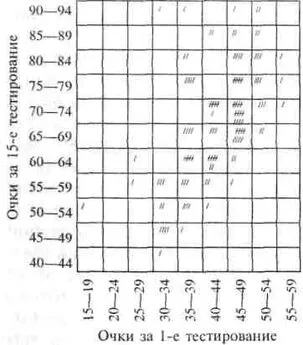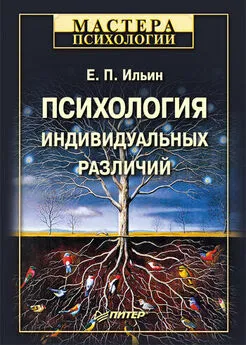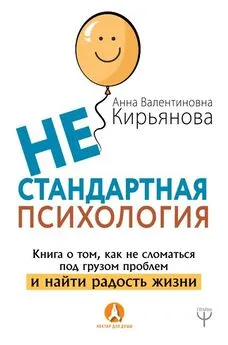Анна Анастази - Дифференциальная психология. Индивидуальные и групповые различия в поведении
- Название:Дифференциальная психология. Индивидуальные и групповые различия в поведении
- Автор:
- Жанр:
- Издательство:ЭКСМО-Пресс
- Год:2001
- Город:Москва
- ISBN:5-04-006108-0
- Рейтинг:
- Избранное:Добавить в избранное
-
Отзывы:
-
Ваша оценка:
Анна Анастази - Дифференциальная психология. Индивидуальные и групповые различия в поведении краткое содержание
Данный фундаментальный труд Анны Анастази зарекомендовал себя как один из лучших классических учебников по дифференциальной психологии мирового уровня, со знакомства с которым должен начинать любой студент, изучающий эту дисциплину. В учебнике в доступной и увлекательной форме рассматриваются проблемы индивидуальных различий человека как отдельного индивида и как представителя той или иной группы, исследуются причины и механизмы его поведения.
Рекомендуется в качестве учебного пособия для студентов, изучающих психологию человека и группы, а также для всех, кто интересуется данной тематикой.
Дифференциальная психология. Индивидуальные и групповые различия в поведении - читать онлайн бесплатно полную версию (весь текст целиком)
Интервал:
Закладка:
30. Foulds, G. A., and Raven, J. С Intellectual ability and occupational grade.
Occup. Psychol., bond., 1948, 22, 197–203.
31. Fryer, D. Occupational intelligence standards. Sch. and Soc, 1922, 16,
273-277.
32. Gee, W. and Corson, J. J. Rural depopulation in certain Tidewater and
Piedmont areas of Virginia. Univer. Virginia soc. Sci, Monogr., 1929, No. 3.
33. Geist, H. Evaluation of culture-free intelligence. Calif. J. educ. Res., 1954,
5, 209–214.
34. Gist, N. P., and Clark, С D. Intelligence as a selective factor in urban-
rural migration. Amer. J. Socioi, 1938, 44, 36–58.
35. Gordon, H. Mental and scholastic tests among retarded children. London:
Bd. Educ, Educ. Pamphlet no. 44, 1923.
36. Gough, H. G. The relationship of socio-economic status to personality
inventory and achievement test scores. /. educ. Psychol., 1946, 37, 527–540.
37. Gough, H. G. A new dimension of status. I. Development of a personality
scale. Amer. socioi. Rev., 1948, 13, 401–409.
38. Gough, H. G. A new dimension of status. II. Relationship of the St scale
to other variables. Amer. socioi. Rev., 1948, 13, 534–537.
39. Gough, H. G. A new dimension os status. III. Discrepancies between the St
scale and «objective status». Amer. socioi. Rev., 1949, 14, 275–281.
40. Haggard, E. A. Social-status and intelligence: an experimental study of
certain cultural determinants of measured intelligence. Genet. Psychol. Monogr., 1954, 49, 141–186.
41. Havighurst, R. J., and Breese, F. H. Relation between ability and social
status in a midwestern community: III. Primary Mental Abilities. /. educ. Psychol, 1947, 38, 241–247.
42. Havighurst, R. J., and Janke, L. L. Relation between ability and social
status in a midwestern community: I. Ten-year-old children. /. educ. Psychol, 1944, 35, 357–368.
43. Havighurst, R. J., and Taba, Hilda. Adolescent character and personality. N.
Y.: Wiley, 1949.
44. Heuyer, G., et al. Le niveau intellectuel des enfants d'age scolaire. Inst.
nat. d" etudes demographiques: Travaux et documents, Cahier 13, 1950.
45. Himmelweit, Hilde T. Socio-economic background and personality. Int.
soc. Sci. Bull, 1955, 7, 29–35.
46. Hirsch, N. D. M. An experimental study of the East Kentucky mountaineers.
Genet. Psychol. Monogr., 1928, 3, 183–244.
47. Hollingshead, A. B. Elmtown 's youth: the impact of social classes on adolescents.
N. Y.: Wiley, 1949.
48. Husen, Т. (Concerning the probiem of selective migration on the basis of
intellectual differences) Studia Psychol. Paedagog., Lund, 1948 2, 30–63.
49. Janke, L. L., and Havighurst, R. J. Relations between ability and social
status in a midwestern community: II. Sixteen-year-old boys and girls. / educ. Psychol, 1945, 36, 499–509.
50. Jones, A. W. Life, liberty, and property. Philadelphia: Lippincott, 1941.
51. Jones, H. E., Conrad, H. S., and Blanchard, M. B. Environmental handicap
in mental test perfofmance. Univer. Calif. Publ. Psychol, 1932 5, No. 3, 63–99.
52. Jordan, A. M. Parental occupation and children's intelligence scores. /.
appl. Psychol, 1933, 17, 103–119.
53. Kinsey, A. C, et al. Sexual behavior in the human male. Philadelphia:
Saunders, 1948.
54. Kinsey, A. C, et al. Sexual behavior in the human female. Philadelphia:
Saunders, 1953.
55. Klineberg, O. A study of psychological differences between «racial» and national
group in Europe. Arch. Psychol, 1931, No. 132.
56. Klineberg, O. Negro intelligence and selective migration. N.Y.: Columbia
Univer. Press, 1935.
57. Klineberg, O. The intelligence of migrants. Amer. Sociol. Rev., 1938, 3,
218-224.
58. Leahy, Alice M. The measurement of urban environment. Minneapolis, Minn.:
Univer. Minn. Press, 1936.
59. Lehman, H. C, and Witty, P. A. The psychology of play activities. N. Y.:
Barnes, 1927.
60. Lichtenstein, M. and Bron, A. W. Intelligence and achievement of children
in a delinquency area. J.juv. Res., 1938, 22, 1—25.
61. Livesay, Т. М. Relation of economic status to "intelligence" and to racial
derivation of high school seniors in Hawaii. Amer. J. Psychol, 1944, 57, 77–82.
62. Loevinger, Jane. Intelligence as related to socio-economic factors. 39 h
Yearb., Nat. Soc. Stud. Educ, 1940, Part I, 159–210.
63. Lynd, R. S., and Lynd, Helen M. Middletown. N/Y/: Harcourt, Brace,
1929.
64. Lynd, R. S., and Lynd, Helen M. Middletown in transition. N. Y.: Harcourt,
Brace, 1937.
65. Maas, H. S. Some social class differences in the family systems and group
relation of pre- and early adolescents. Child Develpm., 1951, 22, 145–152.
66. MacDjnald, Margherita, McGuire, Carson, and Havighurst, R. J. Leisure
activities and the socioeconomic status of children. Amer. J. Sociol, 1949, 54, 505–519.
67. Mailer, J. В. Mental ability and its relation to physical health and social
economic status. Psychol. Clinic, 1933, 22, 101–107.
68. Mauldin, W. P. Selective migration from small towns. Amer. sociol. Rev.,
1940, 5, 748–758.
69. McArthur, C. Personality differences between middle and upper classes. /.
abnorm. soc. Psychol, 1955, 50, 247–254.
70. McCarthy, Dorothea. Language development in children. In L. Carmichael
(ed.). Manual of child psychology. (2 ndEd.) N. Y.: Wiley, 1954, Pp. 492–630.
71. McConnell, J. W. The evolution of social classes. Washington, D. C: Amer.
Coun. Pub. Affairs, 1942.
72. McDonald, H. The social distribution of intelligence in the Isle of Wight.
Brit. J. Psychol, 1925, 16, 123–129.
73. McNemar, Q. The revision of the Stanford-Binet Scale. Boston. Houghton
Mifflin, 1942.
74. Milner, Esther. Effects of sex role and social status on the early adolescent
personality. Genet. Psychol. Monogr., 1949, 40, 231–325.
75. Milner, Esther. A study of the relationships between reading readiness in
grade one school children and patterns of parent-child interaction. Child Develpm., 1951, 22, 95—112.
76. Miner, J. B. Intelligence in the United States: a survey-with conclusions for
manpower utilization in education and employment. N. Y.: Springer, 1956.
77. Neff, W. S. Socio-economic status intelligence: a critical survey. Psychol.
Bull, 1938, 35, 727–757.
78. Phillips, E. L. Intellectual and personality factors associated with social
class attitudes among junior high school children. /. genet. Psychol, 1950, 77, 61–72.
79. Pieter, J. (Intelligence quotient and environment.) Kwart. Psychol, 1939,
11, 265–322.
80. Pope, B. Socio-economic contrasts in children's peer culture prestige
values. Genet. Psychol. Monogr., 1953, 48, 157–220.
81. Preda, G., and Mates, E. (The relation between children's intelligence
and father's occupation). Bui Soc. Psihol Med. Sibiu, 1939, 6, 33–39.
82. Pressey, L. W. The influence of inadtquate schooling and poor environment
upon results with tests of intelligence. /. appl. Psychol, 1920, 4, 91–96.
83. Pressey, S. L., and Thomas, J. B. A study of country children in a good and
a poor farming district by means of a group scale of intelligence. /. appl. Psychol, 1919, 3, 283–286.
84. Radulescu-Motru, С, and Nestor, I. M. (Experimental researches on the
intelligence of the Rumanians.) Acad. Romana, 1948, 50 p. (cf. Psychol. Abstr., 1950, No. 160)
85. Redlich, F. C, et al. Social structure and psychiatric disorders. Amer. J.
Psychiat., 1953, 109, 729–734.
86. Rosea, A. (Intelligence in rural and urban communities). Rev. Psihol,
1939, 2, 131–141.
87. Rosenblum, S., Keller, J. E., and Papania, N. Davis-Eells ("culture-
fair") test performance of lower-class retarded children. /. consult. Psychol., 1955, 19, 51–54.
88. Rusk, R. R. The intelligence of Scottish children. 39 hYearb., Nat. Soc. Stud.
Educ, 1940, Part II, 269–273.
89. Sanford, G. A. Selective migration in a rural Alabama community. Amer.
sociol. Rev., 1940, 5, 759–766.
90. Scottish Council for Research in Education. Social implications of the
1947 Scottish mental survey. London: Univer. London Press, 1953.
91. Seashore, H. G. Differences between verbal and performance IQ's on the
Wechaier Intelligence Scale for Children. /. consult. Psychol., 1951, 15, 62–67.
92. Seashore, H., Wesman, A., and Doppelt, J. The standardization of the
Wechsler Intelligence Scale for Choldren. /. consult. Psychol., 1950, 14, 99-110.
93. Sewell, W. H., Mussen., P. H., and Harris, С W. Relationships among
child training practices. Amer. sociol. Rev., 1955, 20, 137–148.
94. Sherman, M., and Key, Cora B. The intelligence of isolated mountain
children. Child Develpm., 1932, 3, 279–290.
95. Shimberg, Myra E. An investigation into the validity of norms with special
reference to urban and rural groups. Arch. Psychol, 1929, No. 104.
96. Simon, L. M., and Levitt, E. A. The relation between Wechsler-Bellevue
Iq scores and occupational area. Occupations, 1950, 29, 23–25.
97. Sims, V. M. A technique for measuring social class identification. Educ.
psychol. Measmt., 1951, 11, 541–548.
98. Sims, V. M. Sims SCI Occupational Rating Scale: Manual of directions.
Yonkers-on-Hudson. N. Y.: World Book Co., 1952.
99. Sims, V. M. Relations between the social class identification and personslity
adjustment of a group of high school and college students. /. soc. Psychol., 1954, 40, 323–327.
100. Sirkin, M. The relation between intelligence, age, and home environment
of elementary school pupils. Sch. and Soc, 1929, 30, 304–308.
101. Skeels, H. M., and Fillmore, Eva A. Mental development of children
from underprivileged homes. /. genet. Psychol, 1937, 50, 427–439.
102. Skodak, Marie. Children in foster homes: a study of mental development.
Univer. Iowa Stud. Child. Welf., 1939, 16, No. 1.
103. Stendler, Celia B. Social class differences in parental attitudes toward
school at grade-I level. Child Develpm., 1951, 22, 36–46.
104. Stewart, Naomi, A.G.C.T. scores of army personnel grouped by occupation.
Occupations. 1947, 26, 5—41.
105. Straus, M. A. Subcultural variation in Ceylonese mental ability: a study in
national character. /. soc. Psychol., 1954, 39, 129–141.
106. Strong, E. K., Jr. Vocational interests of men and women. Stanford Univer.,
Calif.: Stanford Univer. Press, 1943.
107. Terman, L. M., and Merrill, Maud A. Measuring intelligence. N. Y.:
Houghton Mifllin, 1937.
108. Thomson, G. H. The Northumberland mental tests. Brit. J. Psychol,
1921, 12, 201–222.
Читать дальшеИнтервал:
Закладка:





![Анна Гале - Ведьма? Психолог! [СИ]](/books/1072819/anna-gale-vedma-psiholog-si.webp)




